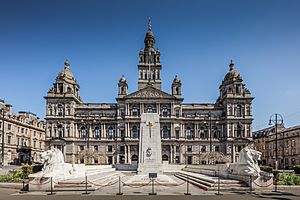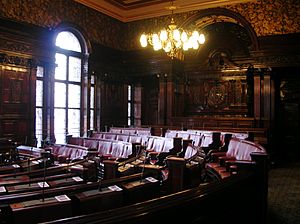Glasgow City Chambers facts for kids
Quick facts for kids Glasgow City Chambers |
|
|---|---|

The front of the City Chambers, from George Square
|
|
| Location | Glasgow |
| Built | 1888 |
| Architect | William Young |
| Architectural style(s) | Victorian style |
|
Listed Building – Category A
|
|
| Designated | 15 December 1970 |
| Reference no. | LB32691 |
| Lua error in Module:Location_map at line 420: attempt to index field 'wikibase' (a nil value). | |
The City Chambers or Municipal Buildings in Glasgow, Scotland, is like the main office for the city's government. It has been the home of the Glasgow City Council since 1996. Before that, it housed other city governments since 1889. You can find this important building on the east side of George Square in the city centre. It is a very special building, listed as a Category A listed building.
Contents
History of the City Chambers
For a long time, Glasgow needed a bigger and better place for its city leaders to meet. The old building, called the Tolbooth at Glasgow Cross, was too small. Glasgow was growing fast and had more important jobs to do. So, in 1814, the Tolbooth was sold, except for its tall steeple, which is still there today. The city council then moved to different places over the years.
In the early 1880s, the city's architect, John Carrick, was asked to find a good spot for a new City Chambers. He chose the east side of George Square, and the land was bought.
Building Design and Opening
After a design competition, a Scottish architect named William Young was chosen. He designed the building in the Victorian style. Construction started in 1882. The building was officially opened by Queen Victoria in August 1888. The first city council meeting happened there in October 1889.
Later, more parts were added to the building. An extension connected by archways across John Street was finished in 1912. Exchange House in George Street was completed in the mid-1980s.
Changes in City Government
The new City Chambers first housed the Glasgow Town Council from 1888 to 1895. Then, a new group called Glasgow Corporation took over. The building remained their main office until May 1975. At that time, the Glasgow District Council was formed under a larger regional council called Strathclyde.
The City Chambers then became the headquarters for the Glasgow District Council. This continued until April 1996, when the Strathclyde region was ended. That's when the Glasgow City Council was formed, and they have been based in the City Chambers ever since.
Architecture and Design
The City Chambers is built in a grand style called Beaux-Arts. This style is a fancy version of Classicism and includes Italianate styles. It has lots of beautiful decorations. These decorations were meant to show how rich and successful Glasgow was. At the time, Glasgow was a very important city for trade and industry in the British Empire.
Outside the Building
The sculptures on the outside of the building were made by James Alexander Ewing. The most important part is the central Jubilee Pediment. This was first planned to show Glasgow sending its goods all over the world. But it was changed to celebrate Queen Victoria's Golden Jubilee.
The Pediment now shows Queen Victoria on her throne. Around her are figures representing Scotland, England, Ireland, and Wales. There are also figures for the colonies of the British Empire, especially British India. Ewing also designed the sculptures at the very top of the building. These figures represent Truth, Riches, and Honour. He also made the statues of The Four Seasons on the building's tower. The central figure of Truth at the top is often called Glasgow's Statue of Liberty. This is because it looks a lot like the famous statue in New York, even though it's much smaller.
Inside the Building
When you enter the City Chambers, you'll see a mosaic of the city's coat of arms on the floor. The coat of arms tells stories about Glasgow's patron saint, Saint Mungo. It has four special symbols: a bird, a tree, a bell, and a fish. These are remembered in a fun rhyme:
- Here's the Bird that never flew
- Here's the Tree that never grew
- Here's the Bell that never rang
- Here's the Fish that never swam
The beautiful banqueting hall is a very large room. It is about 33.5 meters (110 feet) long, 14.6 meters (48 feet) wide, and 15.8 meters (52 feet) high. Its walls are decorated with huge paintings by Scottish artists. Famous people like Nelson Mandela and Sir Alex Ferguson have been honored in this room. They received the Freedom of the City here in 1993 and 1999. The Council Chamber, where city meetings happen, has walls covered in Spanish mahogany wood. Its windows are made of colorful Venetian stained glass.
Gallery
See also
 In Spanish: Edificio del Ayuntamiento de Glasgow para niños
In Spanish: Edificio del Ayuntamiento de Glasgow para niños









